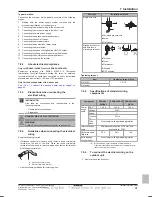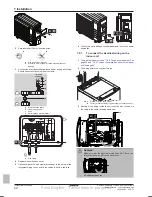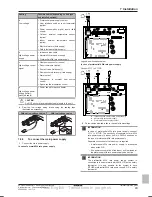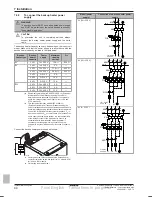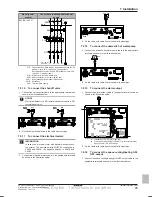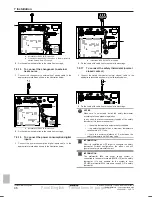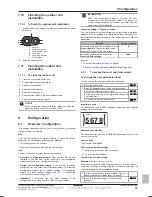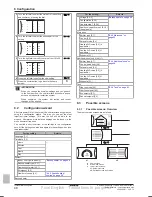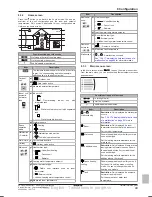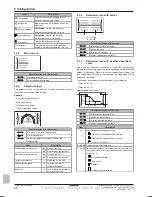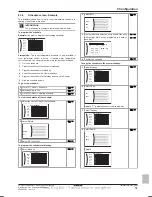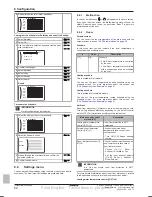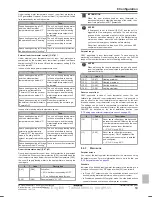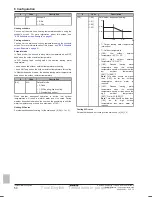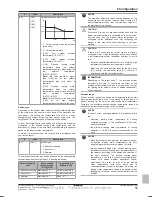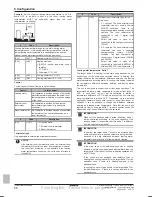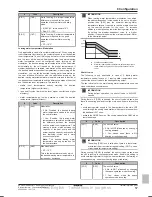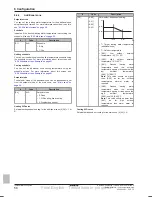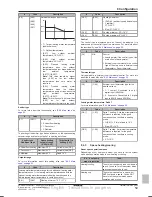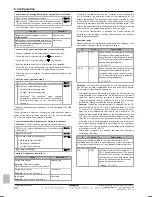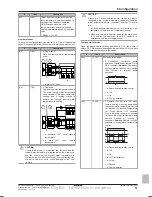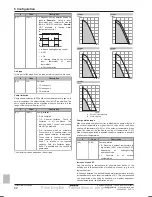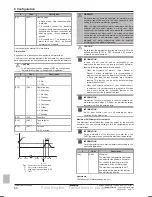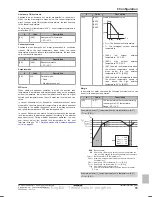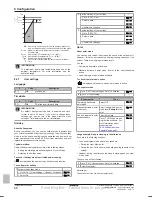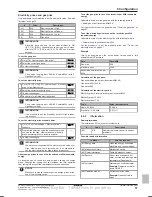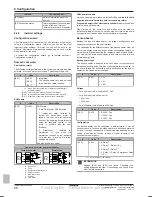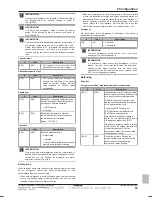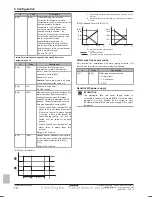
8 Configuration
Installer reference guide
55
ERGA04~08DAV3(A) + EHVH/X04+08S18+23DA
Daikin Altherma – Low temperature split
4P495248-1 – 2017.12
#
Code
Description
[2.6]
[1-06]
[1-07]
[1-08]
[1-09]
Set weather-dependent cooling:
[1-09]
[1-08]
Ta
Tt
[1-06]
[1-07]
▪ T
t
: Target leaving water temperature
(main zone)
▪ T
a
: Outdoor temperature
▪ [1-06]:
Low
outdoor
ambient
temperature. 10°C~25°C
▪ [1-07]:
High
outdoor
ambient
temperature. 25°C~43°C
▪ [1-08]:
Desired
leaving
water
temperature
when
the
outdoor
temperature equals or drops below the
low
ambient
temperature.
[9‑03]°C~[9‑02]°C
Note:
This value should be higher
than [1‑09] as for low outdoor
temperatures less cold water is
required.
▪ [1-09]:
Desired
leaving
water
temperature
when
the
outdoor
temperature equals or rises above the
high
ambient
temperature.
[9‑03]°C~[9-02]°C
Note:
This value should be lower than
[1‑08]
as
for
high
outdoor
temperatures colder water is required.
Emitter type
Depending on the system water volume and the heater emitter type
of the main zone, the heat up or cool down of the main zone can
take longer. This setting can compensate for a slow or a quick
heating/cooling system during the heat up/cool down cycle. The
target delta T for the main zone will depend on this setting.
In room thermostat control, this setting will influence the maximum
modulation of the desired leaving water temperature, and the
possibility for usage of the automatic cooling/heating changeover
based on the indoor ambient temperature.
Therefore it is important to set this correctly and in accordance with
your system layout.
#
Code
Description
[2.7]
[2‑0C]
Emitter type
▪ 0: Underfloor heating
▪ 1: Fancoil unit
▪ 2: Radiator
The setting of the emitter type has an influence on the space heating
setpoint range and the target delta T in heating as follows:
Emitter type Main
zone
Space heating
setpoint range
[9‑01]~[9‑00]
Target delta T in
heating [1‑0B]
0: Underfloor heating Maximum 55°C
Variable (see [2.B])
1: Fancoil unit
Maximum 55°C
Variable (see [2.B])
2: Radiator
Maximum 65°C
Fixed 10°C
NOTICE
The maximum setpoint in space heating depends on the
emitter type as can be seen in above table. If there are 2
water temperature zones, then the maximum setpoint is
the maximum of the 2 zones.
CAUTION
If there are 2 zones, it is important that the zone with the
lowest water temperature is configured as the main zone,
and the zone with the highest water temperature is
configured as the additional zone. Not configuring the
system in this way could cause damage to the heat
emitters.
CAUTION
If there are 2 zones and the emitter types are wrongly
configured, water of high temperature can be sent towards
a low temperature emitter (underfloor heating). To avoid
this:
▪ Install an aquastat/thermostatic valve to avoid too high
temperatures towards a low temperature emitter.
▪ Make sure you set the emitter types for the main zone
[2.7] and for the additional zone [3.7] correctly in
accordance with the connected emitter.
INFORMATION
Depending on the target delta T, the average emitter
temperature will vary. To counteract the effect on the
average emitter temperature due to a higher delta T target,
the leaving water setpoint (fixed or weather dependent)
can be adjusted.
Setpoint range
You can limit the range of the leaving water temperature for the main
leaving water temperature zone. The purpose of this setting is to
prevent a wrong (i.e. too hot or too cold) leaving water temperature.
Therefore, the available desired heating temperature range and
desired cooling temperature range can be configured.
NOTICE
In case of a floor heating application it is important to limit
the:
▪ maximum leaving water temperature at heating
operation according to the specifications of the floor
heating installation.
▪ the minimum leaving water temperature at cooling
operation to 18~20°C to prevent condensation on the
floor.
NOTICE
▪ When adjusting the leaving water temperature ranges,
all desired leaving water temperatures are also
adjusted to guarantee they are between the limits.
▪ Always balance between the desired leaving water
temperature with the desired room temperature and/or
the capacity (according to the design and selection of
the heat emitters). The desired leaving water
temperature is the result of several settings (preset
values, shift values, weather dependent curves,
modulation). As a result, too high or too low leaving
water temperatures could occur which lead to
overtemperatures or capacity shortage. By limiting the
leaving water temperature range to adequate values
(depending on the heat emitter), such situations can be
avoided.
Final English - Tanslations in progress

